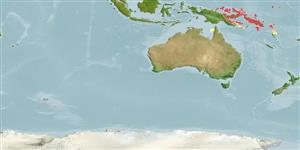Actinopterygii (ray-finned fishes) >
Perciformes (Perch-likes) >
Blenniidae (Combtooth blennies) > Salariinae
Etymology: Ecsenius: Greek, exenios, -os, -on = uncontrolled, immoderate.
Environment / Climate / Range
Ecology
Marine; reef-associated; depth range 3 - 36 m (Ref. 37816). Tropical, preferred ?
Western Central Pacific: Admiralty Islands, Papua New Guinea, and Solomon Islands. Replaced by Ecsenius bathi from Bali to Flores and Ecsenius dilema in the Philippines (Ref. 37816).
Size / Weight / Age
Maturity: Lm ? range ? - ? cm
Max length : 5.8 cm TL male/unsexed; (Ref. 90102)
Short description
Morphology | Morphometrics
Adults occur solitary or forms small groups on coral outcrops (Ref. 90102). Found in clear water, rich coral habitats on coastal to outer reef crests of slopes to about 15 m depth. They live on rocks and corals on steep slopes. (Ref. 48636). Oviparous. Eggs are demersal and adhesive (Ref. 205), and are attached to the substrate via a filamentous, adhesive pad or pedestal (Ref. 94114). Larvae are planktonic, often found in shallow, coastal waters (Ref. 94114).
Life cycle and mating behavior
Maturity | Reproduction | Spawning | Eggs | Fecundity | Larvae
Oviparous, distinct pairing (Ref. 205).
Springer, V.G., 1988. The Indo-Pacific blenniid fish genus Ecsenius. Smithson. Contrib. Zool. (465):134 p. (Ref. 5296)
IUCN Red List Status (Ref. 115185)
CITES (Ref. 94142)
Not Evaluated
Threat to humans
Harmless
Human uses
More information
Age/SizeGrowthLength-weightLength-lengthLength-frequenciesMorphometricsMorphologyLarvaeLarval dynamicsRecruitmentAbundance
ReferencesAquacultureAquaculture profileStrainsGeneticsAllele frequenciesHeritabilityDiseasesProcessingMass conversion
Tools
Special reports
Download XML
Internet sources
